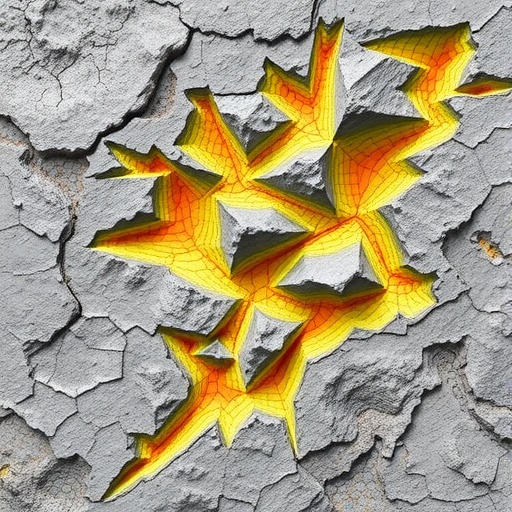In a groundbreaking study, researchers have turned their attention to the intricate world of reservoir rocks and their multiscale pore structures. This innovative investigation leverages the power of machine learning to effectively analyze and characterize the geometrical aspects of these complex systems. The implications of this research stretch far beyond academia, potentially impacting industries ranging from petroleum engineering to environmental science. The study meticulously explores how machine learning can be harnessed to decode the nuanced patterns within the porous architectures of reservoir rocks, paving the way for more efficient extraction processes and enhanced resource management.
Historically, the characterization of pore structures in reservoir rocks has posed significant challenges due to the diverse range of scales and geometries involved. Traditional methods often rely on time-consuming and labor-intensive processes that yield limited insights. However, the advent of advanced imaging techniques, combined with the scalability of machine learning algorithms, has revolutionized the approach to these geological assessments. The researchers utilized high-resolution imaging technologies to capture the pore structures, a technique that allows for an unprecedented exploration of rock composition at microscopic levels.
Machine learning algorithms, particularly those focused on image processing, are designed to discern patterns and anomalies that may be imperceptible to the human eye. By training models on vast datasets of rock images, the team was able to develop predictive tools that can identify and classify various pore structures with remarkable precision. The study illustrates how such algorithms can analyze differences in shape, size, and connectivity of pores, which are critical factors influencing fluid flow within reservoir rocks.
One of the key findings of the research highlights the significance of multiscale analysis in understanding these pore structures. Reservoir rocks are not uniform; they embody a hierarchy of pore sizes that interact in complex ways. By applying machine learning techniques across different scales, the researchers were able to create a comprehensive model that accurately represents the interplay between macropores and micropores. Such granularity is essential for making predictive assessments about fluid dynamics, a crucial aspect of efficient resource extraction.
The researchers emphasized that this approach has the potential to significantly reduce the time needed for characterization while enhancing accuracy. Traditional methods could take weeks or even months to yield results, but by utilizing machine learning, the same analyses can be conducted in a matter of hours. This efficiency could lead to faster decision-making processes in resource management, allowing companies to respond more adeptly to market demands.
Moreover, the application of machine learning in the context of reservoir rock studies is not merely a technical upgrade; it represents a paradigm shift in how geoscience integrates data science. As researchers continue to refine these algorithms, the potential for new insights into geological formations expands exponentially. This is particularly relevant in an era where the large-scale extraction of natural resources must be balanced with sustainable practices.
In addition to practical applications, this research poses fundamental questions about how we understand geological formations. The intricacies of pore structures could influence theories regarding fluid migration, porosity evolution, and even the long-term stability of geological formations. The deep learning models developed in this study could serve as a stepping stone towards more advanced theoretical frameworks, helping scientists uncover the hidden dynamics of subsurface systems.
Furthermore, the implications of this study extend beyond oil and gas industries. The methodologies can be adapted for use in various environmental applications, such as groundwater management and the assessment of carbon sequestration sites. As societies aim to create more sustainable energy systems, understanding reservoir rocks through the lens of machine learning could lead to innovative solutions that better align with ecological stewardship.
The integration of technology and geology is underscored by the researchers’ commitment to reproducibility and transparency. The study openly shares the datasets and algorithms utilized, encouraging other researchers to build upon their findings and apply these techniques to different geological contexts. This commitment to open science not only fosters collaboration but also accelerates the pace of discovery in earth sciences.
As our reliance on natural resources intensifies, optimizing extraction processes through such innovative approaches becomes crucial. The ability to accurately characterize and understand complex pore networks can lead to more efficient resource utilization, reducing waste and enhancing recovery rates. Industries that adopt these technologies may find themselves at a competitive advantage, leveraging more informed strategies to meet the energy demands of a growing global population.
The intersection of machine learning with geological sciences places researchers at the forefront of an exciting era, where interdisciplinary collaborations unlock potentials previously thought unachievable. As these technologies continue to evolve, the possibilities for future applications and discoveries within the realm of earth sciences remain boundless. The need for a more profound understanding of our planet’s subsurface layers is clearer than ever, highlighting the critical role of innovative methodologies in shaping the future of resource management.
In conclusion, the study of multiscale pore structures in reservoir rocks through machine learning not only represents a significant advancement in geological research but also sets the stage for transformative practices in resource extraction and environmental management. The insights drawn from this research underscore the importance of embracing technological advancements to foster a deeper understanding of our natural world. As researchers continue to navigate the complexities of geological formations, the integration of machine learning and traditional geological methods holds the promise of revealing profound truths about the earth’s subsurface, ultimately benefiting both industry and ecology alike.
Subject of Research: Geometrical characterization of multiscale pore structures in reservoir rocks using machine learning techniques.
Article Title: Geometrical Characterization of Multiscale Pore Structures in Reservoir Rocks Using Machine Learning on Images.
Article References:
Jibrin, A., Liu, X., He, X. et al. Geometrical Characterization of Multiscale Pore Structures in Reservoir Rocks Using Machine Learning on Images. Nat Resour Res (2025). https://doi.org/10.1007/s11053-025-10547-1
Image Credits: AI Generated
DOI:
Keywords: Reservoir rocks, pore structure, machine learning, imaging techniques, resource extraction, geology, earth sciences, fluid dynamics, sustainable practices, data science.




